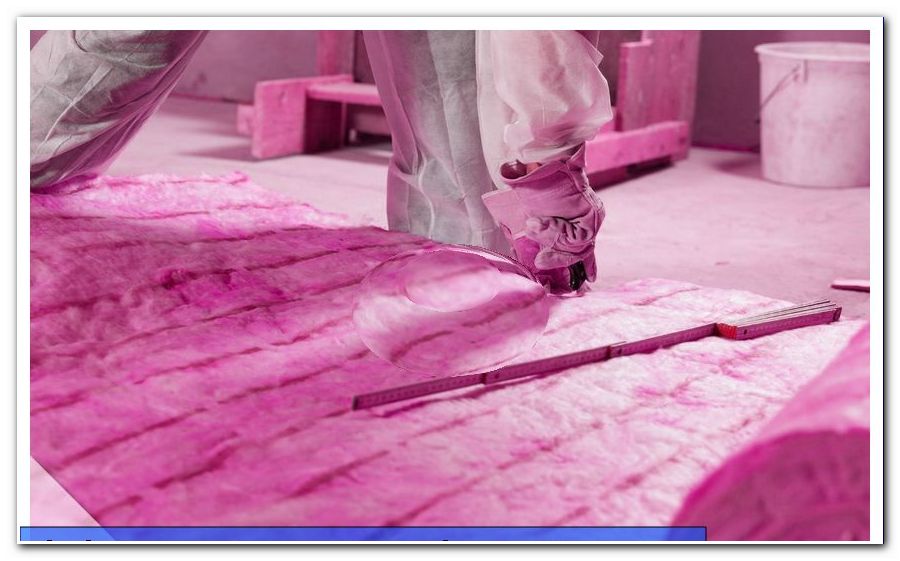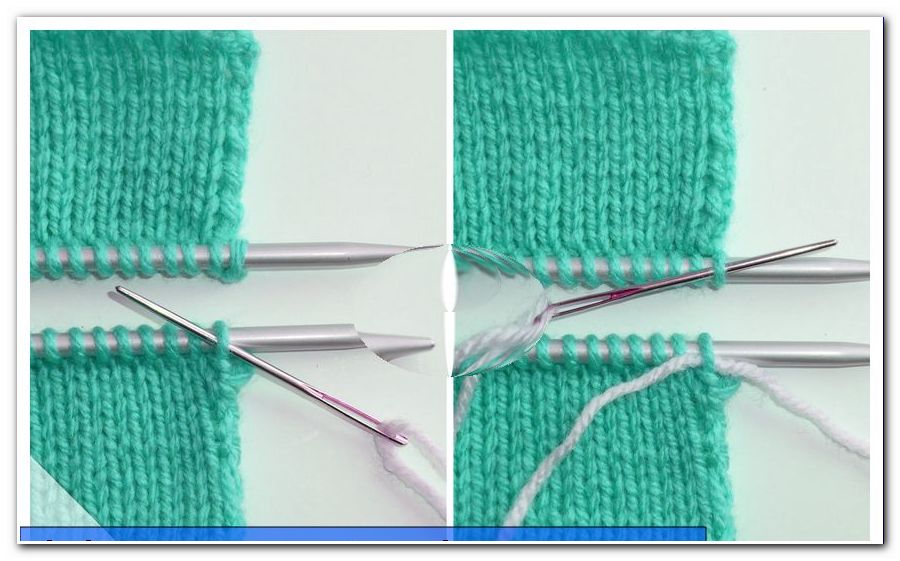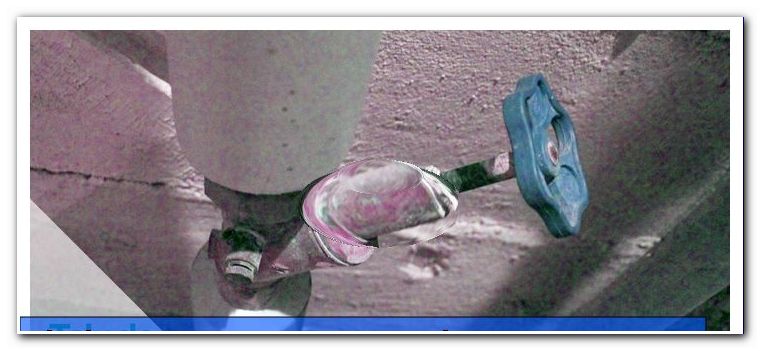Dispose of mineral wool such as glass and rock wool properly

- Problem: mineral wool
- Old and new glass wool
- Differences: glass and rock wool
- Protection during disposal
- Dispose of old mineral wool
- Remove installed mineral wool
- Reuse mineral wool
- 1. Old mineral wool
- 2. New mineral wool
- Dispose of new mineral wool
The popular mineral wool was once rather dangerous. If you find such old glass and rock wool (still common), this is not easy to dispose of properly, the article shows you the way.
Mineral wool is one of the most popular insulation materials today and does not harm anyone. In the past, dangerous glass and rock wool was sold and installed, which you should dispose of properly and in compliance with protection regulations in your own interest. Here is a detailed overview:
Problem: mineral wool
Mineral wool (Kamilit or Kamilitwolle) is the most commonly used insulating material - and as an artificial mineral fiber (KMF) belongs to a problematic material area within the fibers used by humans:
The origin of the raw material distinguishes natural fibers and man-made fibers.
Natural fibers from animals and plants - virgin wool, cotton, cellulose, flax, hemp - do not cause any problems, except perhaps a little bit of scrubbing or scratching. Natural fibers made from fibrous minerals such as asbestos can cause great problems, which you can read more about in the article "Disposal of Eternite Plates".
Artificial Mineral Fibers = KMFs = Inorganic Synthetic Fibers (Crystalline Fibers = Polycrystalline Fibers and Whiskers and Glassy Fibers = Textile Glass Fibers and Wool) also make almost all problems except for the textile glass fibers. Also the wool among them, slag wool, ceramic wool and glass wool and rock wool, which can be carcinogenic.
Mineral fibers are considered critical or carcinogenic if they meet certain conditions. Which prerequisites have not been conclusively explored; how often has human beings first put together artificial connections and sold them in quantities to uncritically progressively believing fellow citizens and then discovered that these products, unfortunately, sometimes annihilate people?
Therefore, there is still no precise and scientifically accurate definition of the factors that make a mineral fiber carcinogenic. Recognized are carcinogenic fibers with certain critical dimensions:
- Fibers from a length of 5 microns
- Fibers thinner than 3 μm
- Fibers over 3 times as long as their diameter
- Seeing or measuring impossible, it's about microns
- 5 μm (5 microns) = 0.005 millimeters, monofilaments visible only under the microscope

- Damage potential due to sufficient bio-resistant fibers
- Bio-resistant: Do not remove fibers efficiently or fast enough by cleaning processes of the body
- Minimum resistance for tumor growth unknown
- Residence time in the organism also depends on the chemical composition
German, no one knows exactly, also the Hazardous Substances Ordinance classifies KMFs according to several criteria: chemical composition, biosolubility of the fibers (basis for the RAL quality mark), results of animal experiments.
In occupational safety, the protective measures against carcinogenic fiber dust are divided into three exposure categories; the higher the level of dust pollution in the workplace, the more comprehensive the protection measures the exposure category provides. As far as the material is concerned: Since almost all inorganic, synthetic fibers have been shown to have a carcinogenic effect in animal experiments, all these fibers are also considered to be suspicious of cancer and, if in doubt, classified in the highest protection category. Glass wool, rock wool, slag wool and ceramic fibers are considered the most carcinogenic substances among the KMFs.
For you, this means that when disposing of mineral wool, you should always adhere to the comprehensive protection measures of the highest protection category (listed below), because you usually handle pieces, so you "fly around" the ears of fibers. And it means that you should risk cancer if you have no information to evaluate the fibers - which is more the case in practice than the opposite.
Old and new glass wool
This assessment is about differentiating "old" and "new" mineral wool, because only the "old" mineral wool is potentially carcinogenic.
"Old" and "new" mineral wool are official terms, they are used in the relevant Technical Rules for hazardous substances, eg. B. the TRGS 521 about demolition, renovation and maintenance work with old mineral wool, here follows the classification:
Basically, there is an increased health risk when dealing with mineral fibers made before 2006. These mineral fibers can cause carcinogens by inhalation depending on fiber size, bio-resistance and respiratory activity, which is why the relevant occupational groups "Technical Rules for Hazardous Substances" (TRGS) must be observed when dealing with such fibers. It does, of course, because there is no reason why a homeowner should consider less than a construction company employee - whether you "get less cancer, " if you only occasionally handle the dangerous material is not safe and not proven.
If the time stamp "made before 2006" irritates you because you've already heard other numbers:
- 01.06.2000: Prohibition of use of "old" mineral wool insulating materials
- Legal basis: Hazardous Substances Ordinance, formerly Annex IV No. 22, today § 16 (2) in conjunction with Annex II No. 5
- Source: www.gesetze-im-internet.de/gefstoffv_2010/BJNR164400010.html
- 1996: German mineral wool manufacturers change production
- From this time RAL quality label for health safety possible
- All stocks were allowed to be resold after 1996
- 2005: Carcinogenic mineral fibers banned throughout the EU
- Old mineral wool possible in all houses built before 2005
- There applies: mineral wool without clearance certificate = cancer risk
Differences: glass and rock wool
There are differences in terms of usage properties such as acoustic insulation capacity, dead weight, fire protection class and density. In terms of disposal and their legal requirements rather not.
If you have a lot of insulation to dispose of, you will need to budget a little more muscle and hours on rockwool because of the higher density.

If you are dealing with glass wool, lack of occupational safety is not just a cancer risk. But it makes itself immediately and in people with sensitive skin very unpleasantly noticeable: The tiny glass fibers penetrate the skin surface, you feel itching, but can not see anything, with each scratching or rubbing of the affected area you may drive the fibers even deeper into the skin ... For such mechanical skin irritation, although the coarser (probably no longer carcinogenic) fibers are responsible for a diameter over 5 microns. But it is also not pleasant if these fibers spit into the skin, there is also talk of inflammatory dangers, already existing skin problems can be strengthened by contact with mineral wool products.
Protection during disposal
When it comes to disposal, it's basically about "keeping the stuff off". First of all, literally, not a dust mineral wool should see your lungs from the inside, but also transferred - the more sensitive your skin, the more carefully you should make sure that your body also above and below the neck does not come in contact with crushed mineral wool.
Here the measures of the TRGS 521, formulated after feasibility in the private household:
- Pay attention to dust-free work
- Do not tear the material, but cut it out of the wall
- Do not use high-speed electric saws without suction
- Do not throw out dismantled material
- Good ventilation of the workplace
- Avoid whirling up dust
- Vacuum fiber dust directly at the exit point
- Pay attention to low-dust cleaning
- Keep your workplace clean from the beginning and clean it regularly
- Do not blow away dust and dust with compressed air
- Do not sweep up dust and dust deposits
- Industrial vacuum cleaner (to borrow in the hardware store, at least category M) use
- Or clean the workplace wet
- Cover poorly cleaned areas with foil in between
- Wear sufficient protective clothing
- Loose-fitting, closed work clothes, eg breathable protective suit type 5 (hardware store)

- Respiratory protection (half / quarter mask with P2 filter / particle-filtering half mask FFP2 / G-26 respirator, filter unit with blower TM 1P)
- Safety glasses, especially when working overhead
- Protective gloves, strong and tight, eg made of leather or cotton gloves with nitrile coating
- After work, rinse the building dust immediately with water
- Then cream sensitive skin with skin care product
- Teach helpers about protective measures
- Provide protective equipment
- Among the helpers should be no adolescents
- No smoking at the workplace
- Washing facilities, also for helpers
- Pack waste immediately and as dust-tight as possible
- Clean or dispose of protective clothing immediately after work
- Separate changing rooms for street and work clothes, laundry room with shower
Dispose of old mineral wool
When it comes to disposal, it's all about keeping other people "off the hook" that comes in contact with the mineral wool.
- For example, employees of transport companies and disposal companies
- Transport waste in tear-proof, dust-tight bags (big bags)
- Or in lockable tons
- Mark containers
- Or submit information on delivery to disposal company
- Labeling or information: Information on nature of the waste, Note "Content may release carcinogenic fiber dust"
- Disposal authority of the municipality has disposal addresses
- Disposal certificate for private households + quantities less than 2, 000 kg per year usually not necessary
- Keep receipt of disposal, if authority z. B. wants to see proof once
- It can be expensive to dispose of small quantities as rubble
- In most districts recycling centers accept small quantities of KMF waste
- Do not damage packaging (do not dump) during transport and unloading
- Dispose of large quantities in accordance with the German Ordinance on the Procurement (NachwV) such as dangerous commercial waste
Remove installed mineral wool
If you have bought a house that is insulated with old mineral wool, and you were not informed at the time of purchase about the problem with this "old mineral wool" - you do not necessarily have to immediately start replacing your insulation, at least that requires Legislator that is not yours:
Properly installed Dämmwollen you can just leave untouched, even from the living area they must not be removed. If the insulation mats are still intact and the insulation has been properly applied, the hazard is considered low. The insulating materials were installed properly if they were covered by a vapor barrier made of foil and covered with a thick cladding made of plasterboard or wood panels or similar. were protected.

Even old mineral wool as thermal insulation on the outer wall or in two-shell masonry usually does not cause increased concentrations of respirable mineral fibers in the interiors.
Critical may be, if suspended ceilings were clad for the purpose of soundproofing with mineral fiber mats, which are not equipped with a functional trickle protection made of fleece and are in the air exchange with the living room. This can then cause higher pollutant concentrations in the room. If this improvement is possible, you should ask a specialist in diseased environmental pollution in case of doubt.
It is even more critical in structural defects or in-house designs that do not meet the current state of the art. The cause quickly once clearly increased fiber concentrations in the air. If you renovate or remodel such building defects and thereby expose the insulation, you should take comprehensive protection measures.
Reuse mineral wool
If you have expanded mineral wool, which actually still looks pretty good, is to be differentiated regarding a re-use:
1. Old mineral wool
The ban on production under the Hazardous Substances Ordinance also includes a prohibition of use, so it is strictly forbidden to install removed "old" mineral wool insulating materials anywhere.
Also, please do not be persuaded that this is not the case in private households - there may once have been loopholes in the law that are the subject of this ever-read story. Today, the legal situation is perfectly clear, according to § 1 Abs. 4 No. 2 in connection with Annex II No. 5 GefStoffV the manufacturing and use restrictions also apply to private households.
Paragraph 1 of Annex II, paragraph 5 (2) does not apply where the synthetic mineral fibers meet one of the following criteria: they have undergone a suitable intraperitoneal test or intratracheal instillation or have had a carcinogenicity index calculated in accordance with Nos. 1 - 3 given results. If you shy away from such certainly not quite cheap tests, you should not and should not continue to use the mineral wool, which is in your doubt in doubt.
2. New mineral wool
New mineral wool with the RAL quality mark for bio-soluble, ie non-carcinogenic mineral fiber products is considered harmless because their fibers are hardly respirable. When they break into small particles, they behave in the body much like normal dust.
If it still looks good, you can easily reuse it to B. prefabricated frame of a house in timber frame construction with insulation boards to fill or the compartments of a wooden stud wall (= truss) to insulate. Stone wool from today's production can even be used as a hydroponic substrate to grow your vegetables or your ornamental plants.
Dispose of new mineral wool
But also proven to be classified as non-carcinogenic KMF waste is not without problems.
Basically, they are considered as Baumischabfall and can easily be disposed of with the garbage (if you do, you should keep the receipts, new mineral wool is indistinguishable from old, that prevents trouble).
For residual material and comminution applies: Even with new mineral wool can result from fiber breakage very short pieces of fiber that you better not breathe. So even when working with the new material protection is recommended, and the contact with the skin can be uncomfortable for sensitive people. Wear at least gloves and long-sleeved clothing or protective clothing, and sensitive people should wear respiratory protection and goggles. Please observe the manufacturer's instructions carefully and ensure good ventilation.




